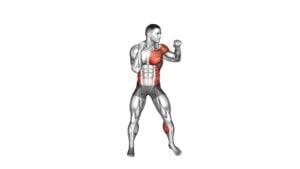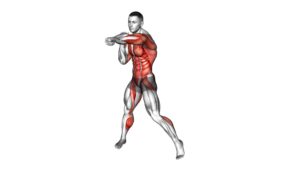Boxing Right Hook – Video Exercise Guide & Tips

Are you ready to level up your boxing skills? Get ready to throw a powerful right hook with our video exercise guide and tips!
Watch This Exercise Video
In this article, we'll break down the basics of the right hook, teach you proper body mechanics for maximum power, and show you how to master footwork and weight transfer.
Avoid common mistakes and take your boxing game to the next level with our advanced tips.
Let's get started and unleash your knockout potential!
Key Takeaways
- Start with a strong stance and maintain proper weight distribution.
- Engage your hips and focus on generating power through proper body mechanics.
- Pay attention to footwork and weight transfer for agility and quickness.
- Avoid common mistakes such as improper stance, neglecting weight transfer, and overextending your arm.
Basics of the Right Hook
Master the technique of the right hook to become a formidable boxer. The right hook is a powerful punch that can turn the tide of a fight in an instant. To execute this technique effectively, you need to understand the proper mechanics and power generation behind it.
The right hook starts with a strong stance, feet shoulder-width apart, and weight evenly distributed. As you throw the punch, pivot your back foot and rotate your hips and shoulders simultaneously. This rotation generates power and allows you to transfer that energy into your fist.
Timing is crucial when throwing the right hook. Wait for the right moment, when your opponent's guard is down or when they're open on the left side. As you throw the punch, aim to hit your target with the knuckles of your middle and index fingers. This will maximize the impact and increase the chances of a knockout.
Remember to keep your elbow bent at a 90-degree angle and maintain a tight fist throughout the punch. The right hook is a short-range punch, so it's essential to maintain good form and accuracy.
Practice this technique diligently, focusing on proper form and power generation, and watch your boxing skills soar to new heights.
Proper Body Mechanics for Maximum Power
To generate maximum power in your right hook, focus on mastering the proper body mechanics. One key aspect is the importance of hip rotation. As you throw the right hook, engage your hips by rotating them in the direction of your punch. This generates a powerful transfer of energy from your lower body to your upper body, resulting in a stronger punch.
Additionally, it's crucial to incorporate shoulder and arm movement effectively. As you rotate your hips, let your shoulder and arm follow through in a fluid motion. This extension of your shoulder and arm adds extra force to your punch, increasing its impact. By combining hip rotation with proper shoulder and arm movement, you'll maximize the power of your right hook.
Transitioning into the subsequent section about footwork and weight transfer, it's important to note that these elements work hand in hand with proper body mechanics. Just as hip rotation and shoulder and arm movement contribute to the power of your punch, footwork and weight transfer play a crucial role in generating force and maintaining balance.
Footwork and Weight Transfer
To optimize the effectiveness of your right hook, utilize proper footwork and weight transfer. Balance and stability are essential for generating power and maintaining control throughout the punch. Make sure to keep your feet shoulder-width apart, with your weight evenly distributed between them.
As you throw the right hook, pivot your back foot and rotate your hips, transferring the weight from your back foot to your front foot. This weight transfer adds momentum to your punch, increasing its power and effectiveness.
Agility and quickness are also crucial in executing a successful right hook. Practice moving in and out of range, constantly adjusting your footwork to maintain optimal positioning. Stay light on your feet and be ready to shift your weight from one foot to the other, allowing you to quickly change direction and launch your punch with precision.
Remember, footwork and weight transfer are the foundation of a powerful right hook. By mastering these techniques, you won't only improve your balance and stability but also enhance your agility and quickness. Incorporate footwork drills into your training routine to develop the necessary skills and muscle memory.
With practice and dedication, you'll be able to deliver devastating right hooks that will leave your opponents in awe. Keep pushing yourself, and never underestimate the importance of proper footwork and weight transfer in boxing.
Common Mistakes to Avoid
Avoiding common mistakes is essential for executing a powerful right hook in boxing. To improve your technique and ensure maximum impact, be aware of these common pitfalls:
- Lack of proper stance: Your feet should be shoulder-width apart, with your lead foot slightly turned inward. This will provide a solid base for generating power and maintaining balance.
- Neglecting weight transfer: Remember to pivot your back foot and rotate your hips as you throw the right hook. This transfers your body weight into the punch, increasing its force and effectiveness.
- Overextending your arm: Don't fully extend your arm when throwing the right hook. Instead, aim to land the punch with your arm slightly bent. This allows for better control and reduces the risk of injury.
By avoiding these common mistakes, you can greatly improve your right hook technique and become a more formidable boxer.
Now, let's dive into some advanced tips for mastering the right hook and taking your boxing skills to the next level.
Advanced Tips for Mastering the Right Hook
To further enhance your right hook technique, it's important to incorporate advanced tips that will help you consistently execute this powerful punch. By mastering advanced techniques, you can improve your accuracy and take your boxing skills to the next level.
One advanced technique to focus on is proper weight transfer. As you throw the right hook, shift your weight from your back foot to your front foot, using your hips and legs to generate maximum power. This transfer of weight won't only increase the force behind your punch but also improve your overall stability.
Another key aspect to consider is the positioning of your arm and fist. Ensure that your elbow is bent at a 90-degree angle and your wrist is straight. This alignment will allow for a more efficient transfer of power and prevent any unnecessary strain on your joints.
Additionally, practice targeting specific areas on your opponent's body to improve your accuracy. Aim for the jaw, temple, or liver for maximum impact. By consistently hitting these target areas, you'll become more proficient in landing clean and effective right hooks.
Frequently Asked Questions
How Long Does It Take to Master the Right Hook Technique?
Mastering the right hook technique takes time and practice. It's a skill that requires precision, power, and proper technique. By focusing on improving the power of your right hook, you can deliver devastating punches.
However, it's important to avoid common mistakes when learning this technique. Keep your elbow tucked in, pivot your hips, and generate power from your legs and core.
With dedication and consistent training, you can master the right hook and become a force to be reckoned with in the ring.
Can the Right Hook Be Used Effectively in Self-Defense Situations?
In self-defense situations, the right hook can be a powerful technique to defend yourself. To maximize its power, focus on using proper technique and body mechanics.
Remember to pivot your feet and rotate your hips to generate maximum force. Timing and accuracy are crucial, so practice your timing by shadow boxing or using a punching bag.
What Are Some Alternative Ways to Practice the Right Hook Without a Partner or Punching Bag?
To practice the right hook without a partner or punching bag, you can try shadow boxing. Picture yourself in a fight and throw powerful hooks in the air. This will help you improve your technique and build muscle memory.
Another option is to use a resistance band. Attach it to a sturdy object and throw hooks against the resistance. This will strengthen your punch and increase your speed.
Keep pushing yourself and never stop improving!
Are There Any Specific Stretches or Warm-Up Exercises Recommended Before Practicing the Right Hook?
Before you start practicing the right hook, it's important to warm up your body and stretch those muscles.
By doing specific stretches and warm-up exercises, you can prevent injuries and enhance your performance.
These recommended stretches will target your arms, shoulders, and core, preparing them for the powerful movement of the right hook.
Remember, warming up properly is key to getting the most out of your training session and ensuring you stay injury-free.
Can the Right Hook Be Modified for Individuals With Physical Limitations or Injuries?
If you have physical limitations or injuries, don't worry! The right hook can be modified to suit your needs. By adapting the right hook for your physical limitations, you can still work on your boxing skills and get a great workout.
It's important to listen to your body and consult with a trainer or medical professional to find modifications that are safe and effective for you. With the right modifications, you can continue to improve your boxing technique and reach your fitness goals.
Conclusion
So, there you have it! The right hook is a powerful and effective punch in boxing. By mastering the proper body mechanics, footwork, and weight transfer, you can generate maximum power and accuracy with this technique.
Remember to avoid common mistakes and keep practicing to perfect your right hook. With dedication and determination, you'll become a force to be reckoned with in the ring.
Keep pushing yourself and never give up!

Author
Years ago, the spark of my life’s passion ignited in my mind the moment I stepped into the local gym for the first time. The inaugural bead of perspiration, the initial endeavor, the very first surge of endorphins, and a sense of pride that washed over me post-workout marked the beginning of my deep-seated interest in strength sports, fitness, and sports nutrition. This very curiosity blossomed rapidly into a profound fascination, propelling me to earn a Master’s degree in Physical Education from the Academy of Physical Education in Krakow, followed by a Sports Manager diploma from the Jagiellonian University. My journey of growth led me to gain more specialized qualifications, such as being a certified personal trainer with a focus on sports dietetics, a lifeguard, and an instructor for wellness and corrective gymnastics. Theoretical knowledge paired seamlessly with practical experience, reinforcing my belief that the transformation of individuals under my guidance was also a reflection of my personal growth. This belief holds true even today. Each day, I strive to push the boundaries and explore new realms. These realms gently elevate me to greater heights. The unique combination of passion for my field and the continuous quest for growth fuels my drive to break new ground.







